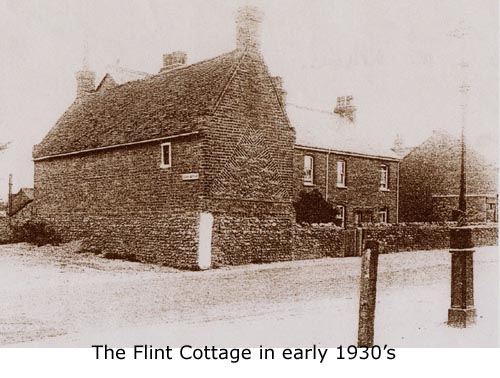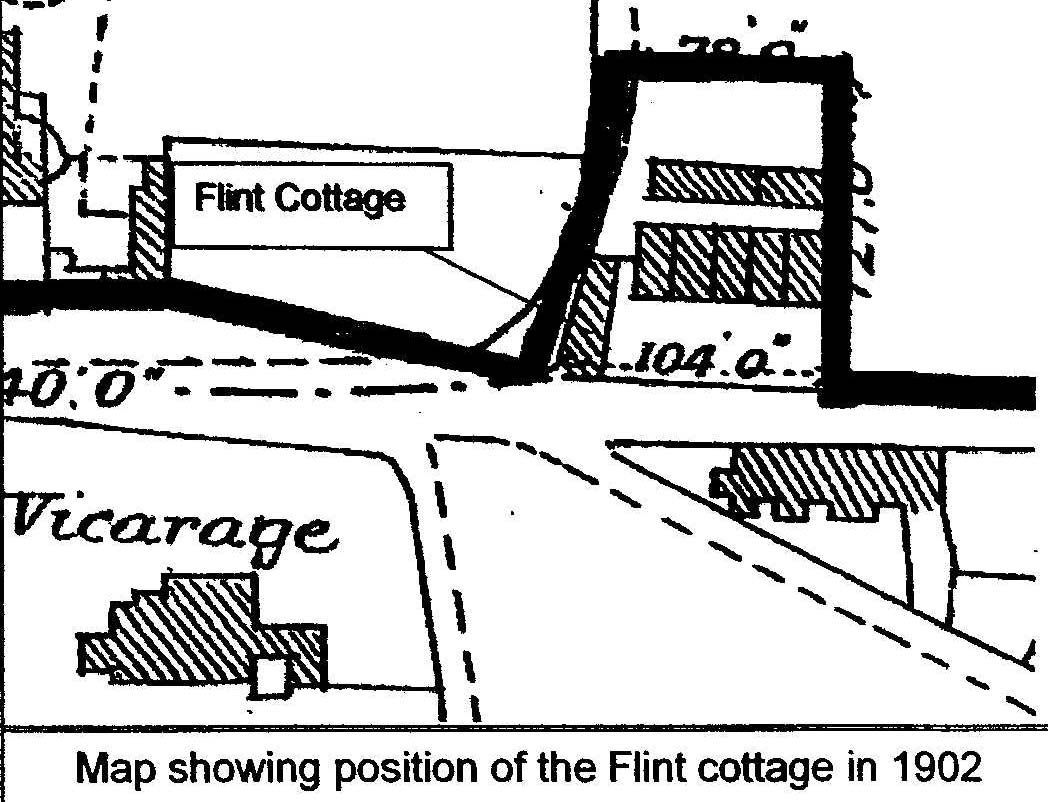|
The
Flint Cottage on the Corner of Park Avenue
by
Jennie Burgess
The photograph of this house
shows a building right on the
roadside of the corner of Park Avenue and Canterbury Road. The house was demolished
in 1933, when the
latter road was widened. The property began life as a single storey
flint
structure. The suggested build date for it is 17th
century, but it
was altered in the 18th century, when an upper
storey was added. The
gables on this are external, with only an initial stepping on the lower
comers,
unlike the more elaborate 'Dutch' gabling on numerous properties in and
around
the Square. It is difficult to see from the photograph what the brick
bonding
is, but it would appear to be more random than Flemish-bonding, which
suggests
that this part is earlier in the 1700's rather than later.
 The
long north wall of the
house has only a
single small window at one end of the upper floor. (The rear wall of
Vine
Cottage is very similar to this.) The end gabled wall has no openings
at all,
the entrance being round on the south side of the house. For all its
humble
appearance in its earliest days, it eventually became a property of
some
size. Because of
this, by 1905, it had
been split into two residences. The terrace of cottages that butt up
close to
the house on the south side, and known as South End Cottages, were
erected soon
after 1895, and are shown on the 1896 map.
Because these stood a little way back from the road,
they escaped
demolition in 1933 road-widening. The
long north wall of the
house has only a
single small window at one end of the upper floor. (The rear wall of
Vine
Cottage is very similar to this.) The end gabled wall has no openings
at all,
the entrance being round on the south side of the house. For all its
humble
appearance in its earliest days, it eventually became a property of
some
size. Because of
this, by 1905, it had
been split into two residences. The terrace of cottages that butt up
close to
the house on the south side, and known as South End Cottages, were
erected soon
after 1895, and are shown on the 1896 map.
Because these stood a little way back from the road,
they escaped
demolition in 1933 road-widening.
 This comer site stands
at a
cross roads
where the lane from Quex Park to Upper and Lower Gore End meets the
road from
St John's (Margate) to Canterbury. The fact that the house is built
right up
against the road, with not even room for a footpath, let alone a garden
in
front on either edge, suggests it was an old site, possibly used from
much
earlier times than the present property. The fact that all the lower,
older
section of the house was built of flint, suggests it must have been
built at a
time when there was a plentiful supply of flint in the vicinity. This comer site stands
at a
cross roads
where the lane from Quex Park to Upper and Lower Gore End meets the
road from
St John's (Margate) to Canterbury. The fact that the house is built
right up
against the road, with not even room for a footpath, let alone a garden
in
front on either edge, suggests it was an old site, possibly used from
much
earlier times than the present property. The fact that all the lower,
older
section of the house was built of flint, suggests it must have been
built at a
time when there was a plentiful supply of flint in the vicinity.
|
 Birchington
Heritage Trust - Newsletter
Birchington
Heritage Trust - Newsletter  Birchington
Heritage Trust - Newsletter
Birchington
Heritage Trust - Newsletter